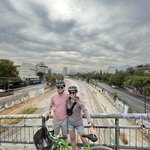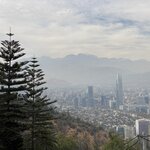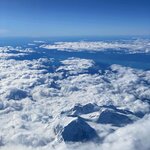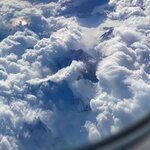Highlights
- Take a day trip from Santiago to the coastal gems of Viña del Mar and Valparaiso
- Tour the lunar landscapes and geothermal wonders of the Atacama Desert
- Hike to the iconic peaks of Torres del Paine National Park
- Visit Easter Island and learn the secrets of the mysterious moai statues
Brief Itinerary
| Day | Highlights | Overnight |
|---|---|---|
| Day 1 | Arrive in Santiago de Chile | Santiago |
| Day 2 | Day Trip to Viña del Mar & Valparaiso | Santiago |
| Day 3 | Fly to San Pedro de Atacama, Moon Valley Tour | San Pedro de Atacama |
| Day 4 | Atacama Desert Tour: Lagoons & Salt Flats | San Pedro de Atacama |
| Day 5 | Tatio Geysers & Machuca Village | San Pedro de Atacama |
| Day 6 | Transfer to Calama, Fly to Punta Arenas | Punta Arenas |
| Day 7 | Transfer to Torres del Paine, Full-Day Excursion | Torres del Paine |
| Day 8 | Torres del Paine: Trekking to the Base of the Towers | Torres del Paine |
| Day 9 | Explore Torres del Paine National Park | Torres del Paine |
| Day 10 | Transfer to Punta Arenas, Fly to Santiago | Santiago |
| Day 11 | Fly to Easter Island | Easter Island |
| Day 12 | Easter Island: Rapa Nui Full-Day Tour | Easter Island |
| Day 13 | Easter Island: Orongo & Ahu Akivi | Easter Island |
| Day 14 | Fly to Santiago & Depart |
Detailed Itinerary
Day 1: Arrive in Santiago de Chile

Welcome to Chile! Upon arrival at Santiago International Airport, a driver will meet you and transfer you to your hotel. You'll have the rest of the day to explore the city at your leisure. Nestled in the foothills of the Andes, Chile's capital of Santiago is a modern and bustling metropolis with pockets of historic ambiance scattered throughout its center. Stroll the cobblestones of Barrio Bellavista, visit the 16th-century Plaza de Armas, or hike to the top of Cerro San Cristóbal for magnificent views.
For dinner be sure to get out of the hotel and enjoy a culinary adventure in the city. In recent years Santiago has emerged as a global foodie destination. Chilean chefs are reinventing traditional dishes like empanadas and cazuelas (stews) with ingredients harvested from the northern deserts and southern Patagonian regions. You can find great restaurants and wine bars not only in the Bellavista neighborhood but also in the revitalized historic barrios of Yungay and Italia.
Day 2: Day Trip to Viña del Mar & Valparaiso

Leave the capital today for an excursion to central Chile's Pacific coast. Start in Viña del Mar, an upscale coastal resort city teeming with shopping complexes, commercial high-rises, boutiques, and well-manicured gardens. The city's modern image is the result of rebuilding after the numerous earthquakes that have hit Chile over the years, but you'll still find some early 20th-century landmarks, like the Germanic Wulff Castle and the Venetian-Gothic Vergara Palace. It's also the perfect place to enjoy a seaside lunch at one of the many upscale restaurants on the shore.
Your next visit is to the port city of Valparaiso, located adjacent to Viña del Mar. This colorful metropolis is known as the artistic and bohemian soul of the country. Filled with street art, music, and poetry, Valparaíso is a throwback to the turn of the 20th century, when electric trollies coasted along the waterfront and lurching funicular elevators carried passengers to the highest points in the city. No matter where you go, you can always find sweeping views looking out over the colorful houses to the coast and the blanket of blue water running out to the horizon.
Start exploring Valparaiso by visiting the old plazas of Sotomayor and Aníbal Pinto. Then hop in the Reina Victoria funicular and ascend to the top. From here you can wander the hilly neighborhoods of Cerro Alegre, Cerro Concepción, and Cerro Florida. It's on this last hill where you'll find La Sebastiana, a museum that was once the home of the famed Chilean poet Pablo Neruda. As your day at the seaside draws to a close, you'll be transferred back to your hotel in Santiago for the evening.
Day 3: Fly to San Pedro de Atacama, Moon Valley Tour

This morning, transfer from your hotel in Santiago to the airport for your flight to Calama. Upon arrival in Calama, transfer to San Pedro de Atacama and get settled at your hotel. Located in the Antofagasta region of the high Chile arid plateau, this small town sits at the edge of the driest desert in the world. Little adobe houses and cozy restaurants are a comfortable base to explore one of Chile's most spectacular and dramatic landscapes.
After you've had a chance to settle in, explore more of this remarkable region with a guided excursion into the nearby Valle de Luna (Moon Valley). Admire its sand dunes and distinctive rock formations that have been shaped by thousands of years of wind and salt erosion, creating an almost lunar setting. End the tour with a colorful sunset from La Gran Duna (the Great Dune) before returning to San Pedro for the evening.
Day 4: Atacama Desert Tour: Lagoons & Salt Flats

Today you'll embark on a full-day excursion into the Atacama Desert. After breakfast, a driver will pick you up at the hotel and you'll head out to the first destination: Laguna Chaxa. Located 31 miles (50 km) from San Pedro, this desert oasis sits in the middle of the Atacama Salar salt flats. Also here is the Los Flamencos National Reserve. Even from afar, you'll be able to spot the Chilean flamingoes that call this reserve home as their pink feathers shine brightly against the contrasting blue of the shallow waters.
At lunchtime, the tour will stop in Socaire, a humble agricultural village famous for its simple adobe homes, rustic chapel, and slow pace of life. After eating, continue toward the Altiplano (high plateau) lagoons of Miscanti and Miñiques, which are located at a whopping 13,779 feet (4,200 m) in elevation. You might feel a bit lightheaded, so try not to exert yourself and be sure to drink plenty of water. Enjoy the panoramic desert views surrounded by towering volcanoes and abounding with wildlife like flamingoes, foxes, and vicunas.
The last stop on the tour is a visit to the town of Toconao, an oasis with a climate ideal for the cultivation of native fruits and vegetables. Stroll the streets, shop for handicrafts, and admire local homes cobbled together out of volcanic rocks. You'll also visit the white-washed church with its famous three-storied bell tower. The church itself dates back to 1750 and has been declared a national monument. As evening falls, return to your hotel and can enjoy the rest of your night in town.
Day 5: Tatio Geysers & Machuca Village
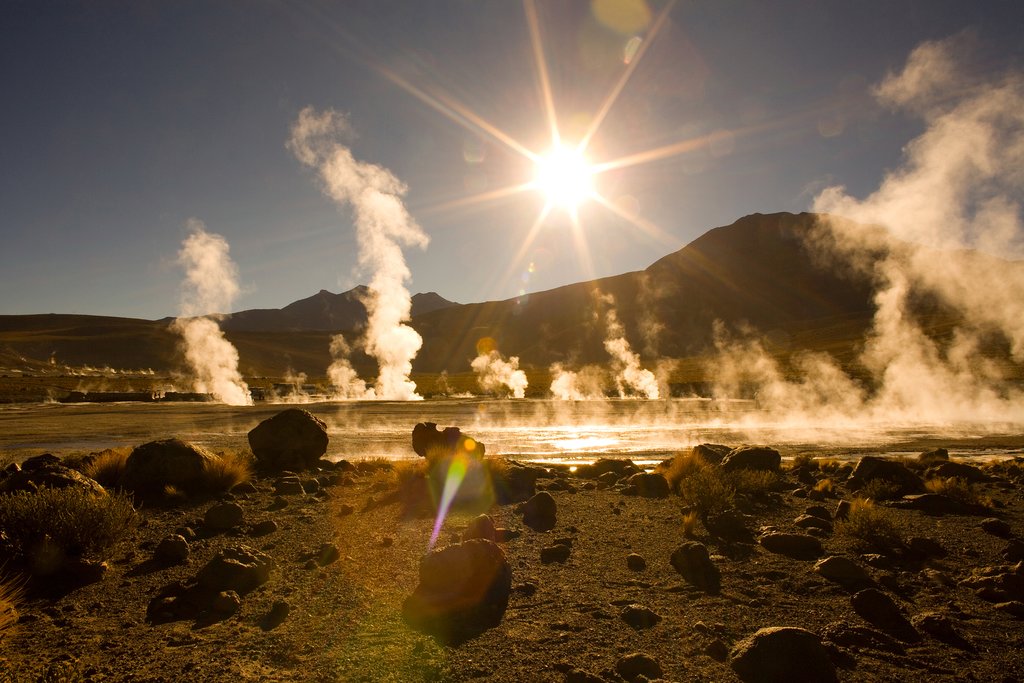
Today's an early start as you depart before dawn on the 1.5-hour trip to the Tatio Geysers. Getting a jump on the day will pay dividends as you're rewarded with the unforgettable sight of a sunrise over the Atacama. At an altitude of 14,173 feet (4,320 m), the Tatio Geysers are the highest in the world, and the contrast between the cold outside temperatures and the boiling water of the geothermal field beneath causes pillars of steam here to rise as high as 30 feet (10 m). Admire the otherworldly landscapes, snap plenty of photos, and enjoy breakfast served on-site.
On the return drive to San Pedro, you'll stop at Machuca, a small, humble village on the Altiplano whose residents have bred llamas and harvested yareta (moss-like evergreen plants that can survive for thousands of years) for generations. It's a small but welcoming town, comprised of only about 20 homes and a simple chapel. Some locals sell crafts, and you can admire the llamas in the area as well as the flamingoes that reside in nearby marshlands. You'll then return to San Pedro for lunch and can spend the remainder of the day relaxing or exploring more of the town.
Chat with a local specialist who can help organize your trip.
Day 6: Transfer to Calama, Fly to Punta Arenas

Bid the desert farewell and transfer to Calama airport for your flight to Punta Arenas via Santiago. Upon arrival, you'll transfer by private car to your hotel. You're now in the major transport hub in one of the most beautiful regions of Chile. Founded in 1848 on the eastern shore of the Brunswick Peninsula, Punta Arenas was once home to the creme de la creme of Patagonian society. Today it's a tourist hub, and from here you can easily access some of the most impressive natural attractions in Patagonia, like Torres del Paine National Park and Magdalena Island.
Spend the afternoon strolling the central Plaza Muñoz Guerrero. This leafy plaza's pathways are lined with French streetlamps and a statue of Magellan sits in the center, surrounded by neoclassical mansions once owned by the monied sheep-ranching families of the 19th century. Be sure to head out in the evening and enjoy a local dinner. Obviously, seafood is the order of the day here, so sample some local specialties, like chupe de centolla (souffle of king crab), as well as oysters, scallops, and other shellfish.
Day 7: Transfer to Torres del Paine, Full-Day Excursion

Early this morning, a transfer takes you to Torres del Paine National Park, one of the most beautiful protected areas on the planet. This 700-square-mile parcel of Patagonian beauty is more than just a UNESCO World Heritage Site—it's also a prime trekking destination. Greeting you at the entrance to the park are panoramic views of the famous Paine Massif: three impressive granite peaks that jut into the sky like giant fingers.
On today's extensive, full-day tour, you'll visit some of the park's main attractions, such as the Amarga Lagoon. Nearby, find the iconic peaks of the Horns of Paine (part of the Cordillera Paine), the glacially-fed Grey Lake, and the thundering waterfalls of Salto Grande. At noon, enjoy lunch at a restaurant in the park before continuing toward the vast Grey Glacier. Along the way, you'll have the chance to observe the park's varied and unique wildlife, such as guanacos, rheas, and condors. At the end of the day, check into our hotel in the park and enjoy a relaxing evening surrounded by nature.
Day 8: Torres del Paine: Trekking to the Base of the Towers

Get ready for an early morning out in Torres del Paine National Park. After breakfast, head off on a hike to the base of the Torres del Paine mountain range, known as Base Torres. This is one of the most popular hiking routes in the park. It can be done in less than a day, but requires a good level of physical fitness. You'll cover 11 miles (18 km) in about nine hours.
Enjoy views of beautiful scenery every step of the way, composed of rivers, native forests, mountain peaks, and narrow valleys. Keep an eye out for local bird species, like condors and black-chested eagles. The route is strenuous, particularly the last stretch right before arriving at the lagoon at the base of the Paine Massif. But once you're staring up at the nearby Cuernos del Paine (Paine Horns) formation jutting into the sky, it'll all be worth it.
Upon arrival, you'll have ample time to rest by the lagoon and marvel at the amazing rock formations as you enjoy a delicious picnic lunch. Afterward, you'll begin the return trip back down the trail. The descent takes approximately four hours, at the end of which you'll arrive back at the hotel for a well-deserved rest.
Day 9: Explore Torres del Paine National Park

Today is free for you to choose between several half or full-day tours throughout Torres del Pain National Park. You might be surprised at how much you can see of the park in just three or four hours. Whether by foot, horse, or vehicle, these half-day guided excursions are packed with adventure and interesting information about the park's flora, fauna, geology, and human history. An experienced guide will take you to impressive natural wonders like the Salto Grande Waterfall and Laguna Azul. All throughout the journey, you'll pass through exotic lenga forests abounding with wildlife.
Full-day excursions tend to last between seven and 10 hours, and they leave in the morning after breakfast at your hotel. Embarking on one of these outings gives you an opportunity to explore the best hiking paths, horse trails, scenic roads, and the various lakes of Torres del Paine. For full-day tours, the hotel will prepare a box lunch that you can take with you, as well as enough water and snacks to keep you energized for your park adventure.
Day 10: Transfer to Punta Arenas, Fly to Santiago

It's time to leave Patagonia behind as you take a private transfer from Torres del Paine National Park to the Punta Arenas airport. You'll then hop on a domestic flight to Santiago. Upon arrival in Santiago, you'll have the remainder of the day to relax and explore at your leisure, perhaps visiting some of the cultural sites, wine bars, or restaurants you may have missed at the beginning of the trip.
Day 11: Fly to Easter Island

Today you'll journey to the most remote inhabited land in the world: Rapa Nui, or Easter Island as it's commonly known. The trip involves a transfer from your hotel to the airport where you'll catch a three-hour flight to the island. After transferring to your hotel and checking in, you can spend the remainder of the day exploring at your leisure.
The island's main hub of Hanga Roa is home to about 3,000 inhabitants and has a charming, small-town coastal vibe. You'll find a selection of restaurants here serving local favorites like ceviche, empanadas stuffed with fresh tuna, po'e (a pumpkin and plantain cake), and taro ice cream. For insight into Easter Island's history, head to the Museo Antropológico Sebastián Englert, an anthropological museum with exhibits on the island's ancient tools, totems, sculptures, and more.
For incredible sunset views, take a hike outside of town to Ahu Tahai to see some of the island's iconic moai (stone figures). Standing on the stone ahu (ceremonial pillars) that dot the green hillsides all over the island, you'll find over 600 moai—some of which reach 32 feet (10 m) in height. Fashioned out of volcanic rock by the first Polynesian settlers after they arrived in 800 CE, the figures themselves represent deceased leaders of the five tribes that once inhabited Rapa Nui, and supposedly offered spiritual protection.
Day 12: Easter Island: Rapa Nui Full-Day Tour

Embark on a full-day tour of the island today for an informative journey that will shed light on Rapa Nui's famous archeological sites. You'll start at Ahu Te Pito Kura, a unique rock structure featuring a central stone that, legend has it, was brought over by a king of the first tribes and supposedly still emits spiritual power.
Then it's off to Rano Raraku, an impressive volcanic crater, at the base of which you will find many moai. After that, you'll enjoy a delicious snack at Ahu Tongariki, which is considered the biggest ceremonial platform on the island. Here there are fifteen moai displayed in a row. After touring the site, you'll visit another ceremonial platform called Ahu Akahang and finish the day at the beautiful white-sand beach of Anakena.
Day 13: Easter Island: Orongo & Ahu Akivi

Today you'll discover the cultures and traditions of Easter Island with two half-day tours to Orongo and Ahu Akivi. Start at the remains of the village of Orongo, located on the rim of an inactive volcano called Rano Kau. This area enjoys a special place in the island's history, as it was the principal site of what's known as the "Birdman" era. You'll have time to visit the village and the volcano, as well as a cave by the sea known as Ana Kai Tangata, where you can view petroglyphs fashioned by the ancient inhabitants of the island.
The second tour takes you about a mile inland to visit Ahu Akivi. This remarkable site is home to seven moai, and in ancient times it doubled as a celestial observatory. In other words, this is where islanders came to stargaze. An interesting feature is that the seven moai all face sunset during the spring equinox, and their backs are to the sunrise during autumn. While here, you can visit the extinct volcano of Puna Pau, which served as the quarry for the red scoria stone which adorned the island's iconic statues. Following the tours, you'll be transferred back to your hotel to spend the evening at your leisure.
Day 14: Fly to Santiago & Depart

Today marks your last day on the island! Depending on your flight schedule, you should have some free time to explore Rapa Nui a bit more before transferring to the airport. You'll then hop a flight back to Santiago and catch your connecting flight home. Safe travels!
More Great Chile Itineraries
Looking for more inspiration for your trip to Chile? Check out these other Chile itineraries, explore different ways to spend two weeks in Chile, or discover the best time to visit Chile.



